#Saadi Dynasty
Explore tagged Tumblr posts
Text
And I was told, “Pray for him respectfully — it is the grave of a lover.”
— SULTAN ZIDAN ABU MAALI ⚜️ Poems for the Millennium, Volume Four: The University of California Book of North African Literature, anonymous transl. from Arabic, (2013)
#Moroccan#Sultan Zidan Abu Maali#Saadi Dynasty#Poems for the Millennium#Volume Four: The University of California Book of North African Literature#(2013)
13 notes
·
View notes
Text

Shiraz, Iran, holds a rich history with settlements dating back to 5500 BC. It flourished under Islamic rule, becoming a cultural hub in the 13th century, known as "The Athens of Iran" for its scholarly and artistic contributions. Renowned poets Hafez and Saadi were born here, adding to its literary legacy. Under later dynasties, Shiraz continued to thrive as a center of art, knowledge, and trade.
5 notes
·
View notes
Text
The gunpowder revolution in Africa and the ultimate horrors in its train began with the Battle of Tondibi:
The Battle of Tonbidi is one of history's forgotten turning points and a key one that it should be emphasized would both play a key role in the rise of African diaspora communities across the Americas. The Songhai Empire, which had eschewed the firearms of Kanem-Bornu and Morocco marched in great confidence to face firearms and cannons, much like the Safavid Shah Ismail I would against Selim the Grim at Chalidran. The triumph of the will rode in glorious banners singing in triumph.
The muskets and cannons mowed them down like wheat upon the fold and nothing was ever the same again. The horrors of the Atlantic Slave trade and the beginning of global Black history as we know it all began because of that single opportunistic strike by the Saadi and the hubris of the Songhai in assuming that what had worked for millennia would always do and the blunt illustration of what happens when this assumption proves fatally incorrect.
This is equally a point worth noting in one other very blunt way, Islam *became* an anti-colonialist force when European power began to assert itself in Africa. Prior to that it was as much a wrecking ball as a source of strength and it was never a sure thing for African cultures as to which side of the Ummah would prove there at any given moment.
#lightdancer comments on history#black history month#military history#against eurocentrism#islamic history#saadi dynasty#battle of tondibi#one of history's forgotten events given how much evil spun out of it
0 notes
Text
Events 3.13
624 – The Battle of Badr, the first major battle between the Muslims and Quraysh. 1567 – The Battle of Oosterweel, traditionally regarded as the start of the Eighty Years' War. 1591 – At the Battle of Tondibi in Mali, Moroccan forces of the Saadi dynasty, led by Judar Pasha, defeat the Songhai Empire, despite being outnumbered by at least five to one. 1639 – Harvard College is named after clergyman John Harvard. 1697 – Nojpetén, capital of the last independent Maya kingdom, falls to Spanish conquistadors, the final step in the Spanish conquest of Guatemala. 1741 – The Battle of Cartagena de Indias (part of the War of Jenkins' Ear) begins. 1781 – William Herschel discovers Uranus. 1809 – Gustav IV Adolf of Sweden is deposed in the Coup of 1809. 1811 – A French and Italian fleet is defeated by a British squadron off the island of Vis in the Adriatic during the Napoleonic Wars. 1826 – Pope Leo XII publishes the apostolic constitution Quo Graviora in which he renewed the prohibition on Catholics joining freemasonry. 1845 – Felix Mendelssohn's Violin Concerto receives its première performance in Leipzig with Ferdinand David as soloist. 1848 – The German revolutions of 1848–1849 begin in Vienna. 1862 – The Act Prohibiting the Return of Slaves is passed by the United States Congress, effectively annulling the Fugitive Slave Act of 1850 and setting the stage for the Emancipation Proclamation. 1884 – The Siege of Khartoum begins. It lasts until January 26, 1885. 1888 – The eruption of Ritter Island triggers tsunamis that kill up to 3,000 people on nearby islands. 1900 – British forces occupy Bloemfontein, Orange Free State, during the Second Boer War. 1920 – The Kapp Putsch briefly ousts the Weimar Republic government from Berlin. 1930 – The news of the discovery of Pluto is announced by Lowell Observatory. 1940 – The Winter War between Finland and the Soviet Union officially ends after the signing of the Moscow Peace Treaty. 1943 – The Holocaust: German forces liquidate the Jewish ghetto in Kraków. 1954 – The Battle of Điện Biên Phủ begins with an artillery barrage by Viet Minh forces under V�� Nguyên Giáp; Viet Minh victory led to the end of the First Indochina War and French withdrawal from Vietnam. 1957 – Cuban student revolutionaries storm the presidential palace in Havana in a failed attempt on the life of President Fulgencio Batista. 1969 – Apollo 9 returns safely to Earth after testing the Lunar Module. 1974 – Sierra Pacific Airlines Flight 802 crashes into the White Mountains near Bishop, California, killing 36. 1979 – The New Jewel Movement, headed by Maurice Bishop, ousts the Prime Minister of Grenada, Eric Gairy, in a coup d'état. 1988 – The Seikan Tunnel, the longest tunnel in the world with an undersea segment, opens between Aomori and Hakodate, Japan. 1992 – The Mw 6.6 Erzincan earthquake strikes eastern Turkey with a maximum Mercalli intensity of VIII (Severe). 1993 – The 1993 Storm of the Century affects the eastern United States, dropping feet of snow in many areas. 1996 – The Dunblane massacre leads to the death of sixteen primary school children and one teacher in Dunblane, Scotland. 1997 – The Missionaries of Charity choose Sister Nirmala to succeed Mother Teresa as their leader. 2003 – An article in Nature identifies the Ciampate del Diavolo as 350,000-year-old hominid footprints. 2012 – The Sierre coach crash kills 28 people, including 22 children. 2013 – The 2013 papal conclave elects Cardinal Jorge Mario Bergoglio taking the name Pope Francis as the 266th Pope of the Catholic Church. 2016 – The Ankara bombing kills at least 37 people. 2016 – Three gunmen attack two hotels in the Ivory Coast town of Grand-Bassam, killing at least 19 people. 2020 – President Donald Trump declares the COVID-19 pandemic to be a national emergency in the United States. 2020 – Breonna Taylor is killed by police officers who were forcibly entering her home in Louisville, Kentucky; her death sparked extensive protests against racism and police brutality.
0 notes
Text
Good afternoon TUMBLR - March 9th - 2024
''Mr. Plant has owed me a shoe since July 5, 1971."
Ch. XI.3 - Morocco - 1989 - 1991
TAROUDANT - MARRAKECH
Like every year, at the end of the Holy month of Ramadan there were the festive days of Eid el Fitr. Officially lasting two days, but infact we could count in a week of rest.
The trains, the CTM (La setième in local language) and the collective Grand Taxis - generally old Mercedes or Pegeot 504s that connected the various cities of Morocco, increased ticket prices based on the proximity of the Eid date. The workers began to ''flee'' in the days preceding the festival, with the excuse of the long journeys they had to face to reach their places of origin (mon bled) and the scarcity of means of transport.
We decided to spend the holiday visiting Taroudant and than Marrakesh. Taroudant, a town about 80 km from Agadir, is known as the "Grandmother of Marrakech" because it looks like a smaller Marrakech with its surrounding ramparts. In the 16th century, the Saadi dynasty briefly used Taroudant as its capital before moving its royal seat to Marrakesh. Today, the town has the feel of a small walled market town on a caravan route.
We stayed overnight in a beautiful Arab-style hotel, with lush gardens and a beautiful swimming pool right next to the ocher walls that surround the city, 8 km long. I remember that Andrea had a lot of fun in that pool, and when it was time to leave it he stung his hands and feet because he didn't want to go.
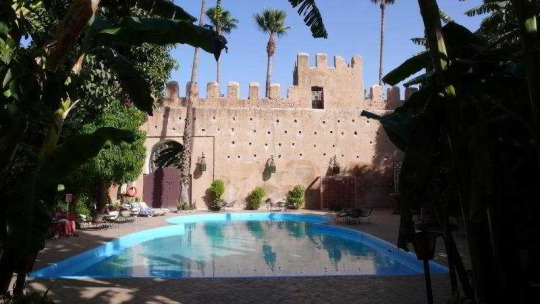
The next day, after having studied the road map (GOOGLE MAP did not yet exist) we decided to leave for Marrakesh, even passing through the legendary Tizi n'Tichka (literally ''pasture pass''), a pass that rises to the considerable altitude of 2,260 meters and which, crossing the High Atlas, connects the Taroudant valley with Marrakech. At its peak you can admire the highest peak in North Africa, Mount Toubkal 4,167 meters high (from the Berber Tugg Akal the ''One who looks down on the Earth'').
It was a trip that I remember with particular pleasure for the wild beauty of the places we crossed. At a certain point, after long kilometers of descent full of hairpin bends, Marrakech appeared in the light of the sunset, further accentuating the red-ochre color of its walls and ancient buildings. We spent a couple of days in Old Capital in a nice hotel which I think today is called Ryad Mogador, and then we returned to Agadir.
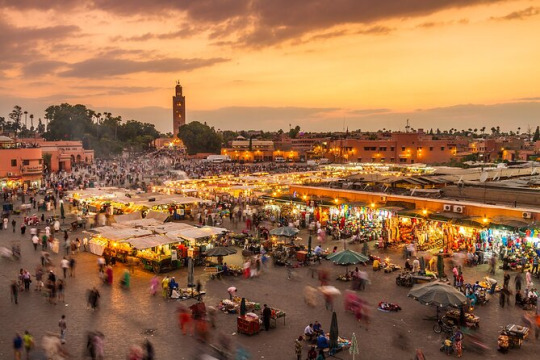
TAFRAOUT
After some time had passed since the failed visit to the caves, Bozon tried to try to regain some credit. He therefore proposed a trip to us which first consisted of a stop in Tiznit - about a hundred kilometers south of Agadir, and then an overnight stay in Tafraout, an inland town.
Tiznit is a small Berber city, famous above all for its artisans who work with silver and steel to make jewellery, swords, inlaid knives, a whole variety of beautiful objects which are made in the traditional way in the kasbah's workshops.
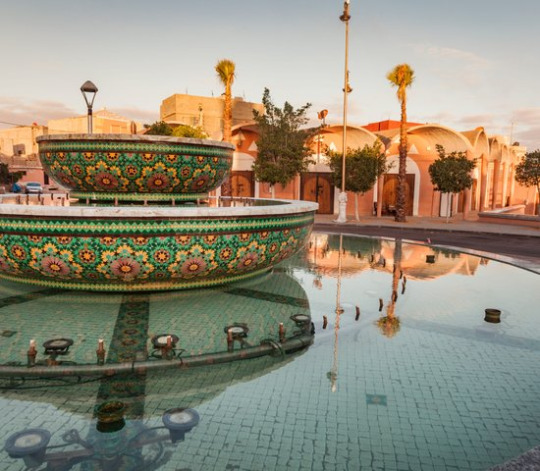
In addition to the three of us, Bozon, my colleague Alfio and his wif, who recently arrived from Italy, were taking part in the 2-day excursion.
After the pleasant visit to Tiznit, we headed towards Tafraout, at a distance of about 100 kilometers, deep on Berber territory. A winding but well-maintained mountain road, with a pass at 1,230 meters above sea level, where a wealthy Berber trader who emigrated to France built a large hotel. The hotel was visible from far away, surrounded as it is by the ocher of the bare mountains. Stubborn date palms grow here and there.
Hotel Kerdous - Tafraout, Morocco
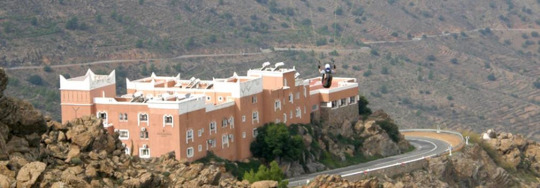
Tafroute is renowned for the cultivation of almonds, the basic fruit for many traditional Moroccan pastry desserts.
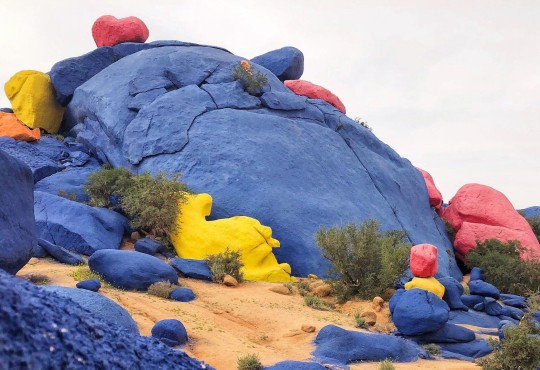
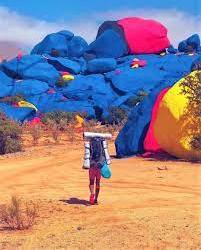
About 8 km from Tafroute there is the famous area of the painted rocks. Jean Verame, a Belgian artist, brought in 19 tons of paint of various colors in the late 1980s and than painted the rocks with the help of local people.
And that's where we spent the day, on a sort of plateau surrounded by large, colorful granite rocks, some used like a primary school notebook, with black rods on a white background or vice versa. At a certain point, however, here is the usual unexpected event of the day: this time it is offered to us by Alfio who, as sea man, thinks he can transforming himself into a boulder free climber. Without saying a word to anyone (what Sardinian would he be if he spoke to someone about his intentions?) having chosen a rock he began to climb it. Till to the point of no return, in the sense that at about 15 - 20 meters from the ground he no longer knew how to go up or come down. Mrs. Curreli, having noticed her husband's impasse, began at first to shout at her husband nasty insults (which we did not understand the meaning, given that they were pronounced in strict Sardinian) then with suggestion on how to get down from the uncomfortable position.
- Hang on there……put your foot lower……be careful not to fall…idiot '' Alfio, poor thing, was in a panic, and we all could see it from the tremor that shooked his legs and feet, resting on the precarious rock's niches. Bozon and I were amused at first, but we start to be worry when we saw that the situation was becoming critical. We therefore made sure to get up as close as possible to Alfio, to comfort him and suggest the best way to get off. In the meantime I asked Mrs. Curreli to stop shouting. In short, after a series of maneuvers while telling encouraging words - ''come on, you're doing well…. like this…. like that …slowly…no worry …'' we managed to bring Alfio back to the ground. The guy, once lying on the lawn, had a sort of fainting spell, which did not prevent his wife from hurling yet another series of insults at him.......
We returned to Agadir via the R105 national road, a good road passing through Ait Baha, with breathtaking views of the Anti-Atlas.
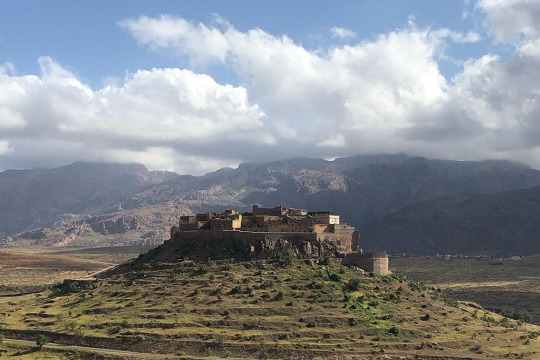
GULF WAR It was August 2, 1990 and na ews shocked the entire World: Iraq, with a surprising offensive launched during the night, had invaded neighboring Kuwait!! Morocco, a moderate Arab country, assumed an equidistance position on the conflict through a televised speech by His Majesty Hassan II. A moderation action through privileged diplomatic channels was matched by concern about the protection of the Holy Places of Mecca and Medina - currently not directly affected by the conflict. Morocco in any case sent a symbolic contingent of 1,500 soldiers, after the agreement with Saudi Arabia, to defend Mecca and Medina in the event of an attack. The tension was felt throughout Morocco, with demonstrations by the population in open support of Saddam. Even in the site offices, Moroccans showed open support for Saddam, in open contrast to the official positions of the Government. There were also a couple of curious episodes, due to the fact that my Range Rover still had the red license plate of Bahrain, a Gulf Emirate which for obvious reasons since the beginning of the conflict had sided with Kuwait and the nascent coalition led from the USA. One day I stopped at a petrol station to fill up with petrol, and the guy addressed me with phrases in Arabic and French, making me understand that ''there was no fuel for the traitors of the Iraqi brothers''!! I finally managed to make him understand that I was not Bahraini, but Italian, that I had bought the car years ago there– and so I got the petrol. Another unpleasant episode happened a few days later – after a breakfast at the restaurantJardin d'Eau. I was leaving the place, and fortunately M. David accompanied me. A crowd of youngster were kicking the my car for the same reason: they had seen the Bahrain license plate and believed that the ''traitors of the great leader Saddam needed to be taught a lesson''!! David managed to bring them to their senses, making them feel ashamed for what they were doing to a car belonging to a ''Respectable Italian engineer working at the New Aeroport d'Agadir''!! In any case, the Gulf War had already generated a phenomenon that, at the time, I couldn't understand: all the foreign tourists had suddenly disappeared from Agadir (and I presumed from all over Morocco), causing the closure of hotels, restaurants and travel agencies. And of all the consequences that the presence of foreigners set in motion. The reason behind this was that since Morocco is an Arab country, people believe it could somehow become involved in the conflict at any moment. Hence all foregneirs fled a country situated 5,000 km away from the war front! We therefore arrived in a state of high tension on January 15, 1991, when His Majesty King Hassan II spoke to the world and to the nation, in a heartfelt message to "brother Saddam", clearly saying that his was "the last appeal before the possible catastrophe''. We therefore understood that the time for the American attack was imminent, and in fact during the night the bombers of the Coalition of 39 countries attacked Kuwait and Iraq simultaneously. My Boss, Alfonzo, based on the instructions received from the Company headquarters, ordered us not to move from home. And for three long days it was like thas: a grave silence had descended over the city - only the police of Gendarmerie Nationale circulated the streets, even if officially the Authorities had not declared any restrictions on free movement. One of the statements that made us understand the Moroccans' state of mind towards us materialized following the shooting down and capture of an Italian Tornado fighter. Some people were waiting for us that day at the entrance to the site offices, and welcomed us saying: ''Nous avons abattue un de vos jet'' (We shot down one of your jets) A somewhat grotesque statement, if we consider that Morocco did not participate in the war - and therefore that ''we'' meant total adherence to the Iraqi cause, seen as Pan-Arab and against the American Imperialists and their allies.
1 note
·
View note
Text
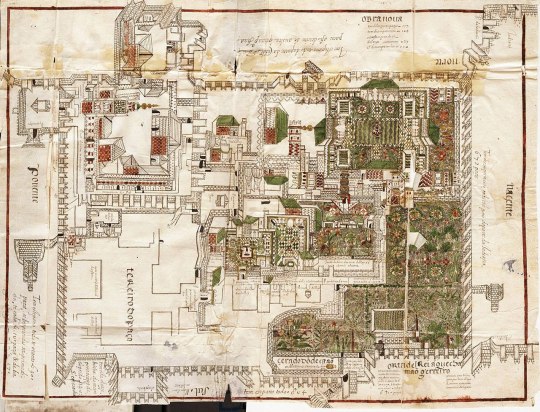
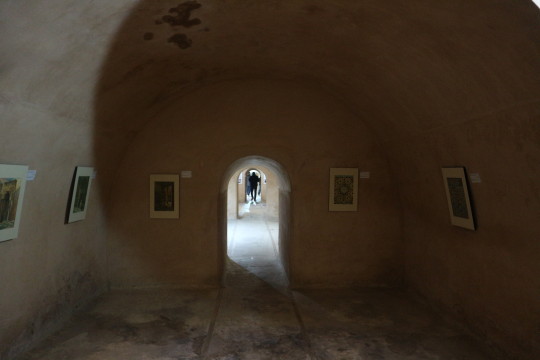
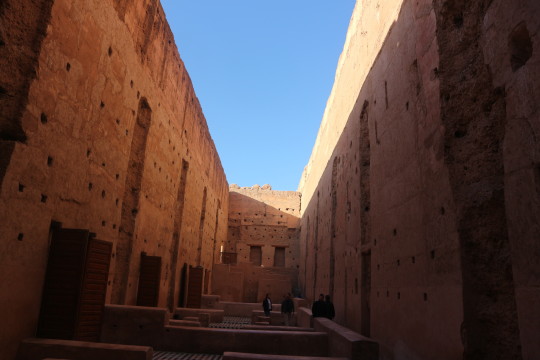
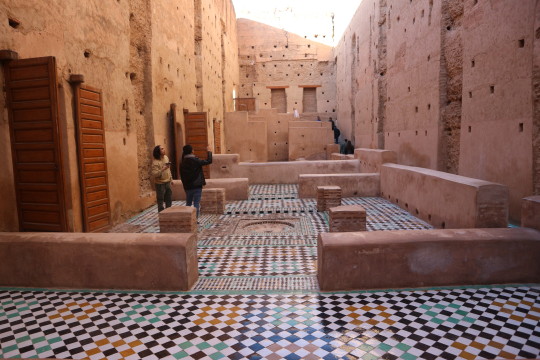
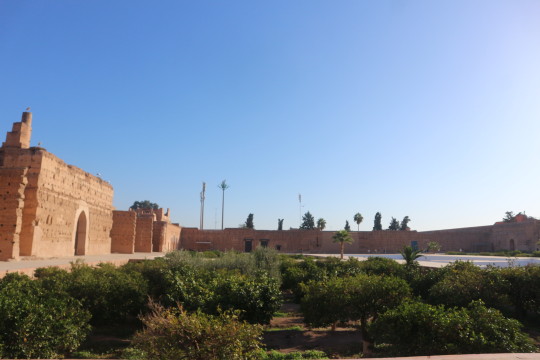
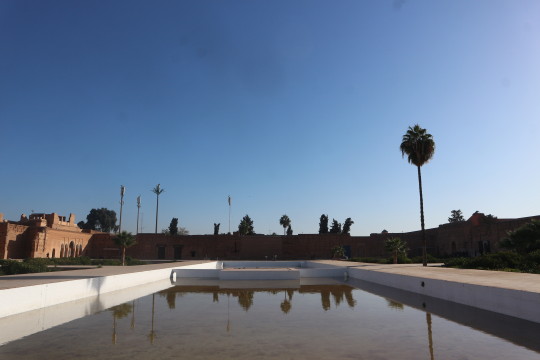
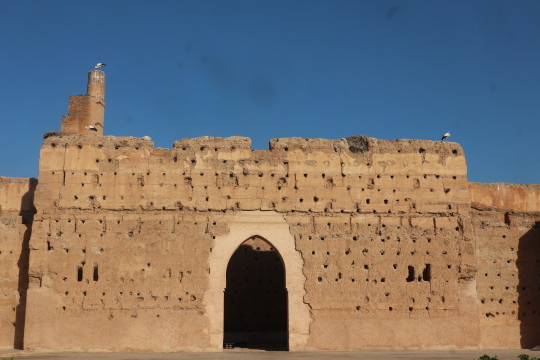
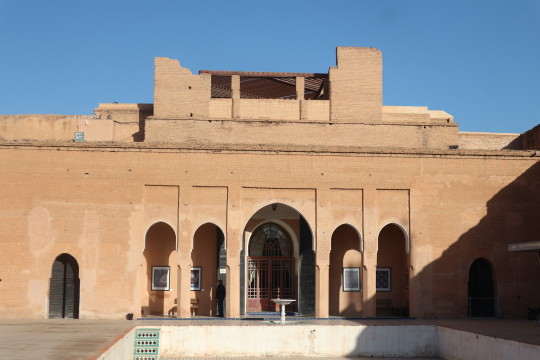
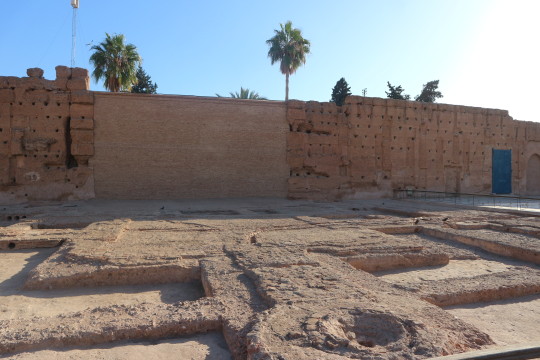
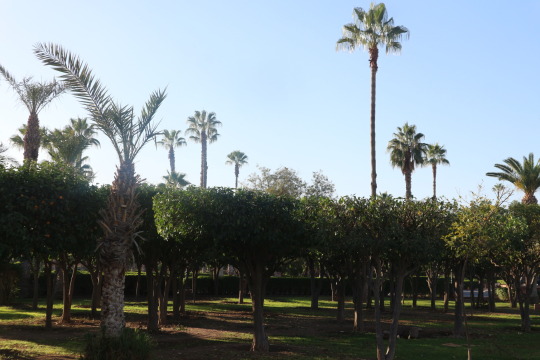
The Incomparable.
The fifth part in my Morocco series (please see here, here, here, here and here for more).
This is El Badi palace (today’s post is only about the time this was built and destroyed; please see here for earlier history and here for later history).
El Badi was built in 1578 by Ahmad al Mansour, sixth of the Saadian Dynasty, who ruled Morocco from 1549 to 1669, having taken over from the Wattasids, who were unpopular for losing the European empire that was ruled from this city from its founding in 1070 until the expulsion of the Wattasids in 1492 from what became the kingdom of Spain.
In the same year, the Spaniards expelled all Jews and Muslims, even though they had lived there for hundreds of years, and many fled to Morocco, thus bolstering the European influence (workers from around the world, Europeans as well as Moroccans, were employed in the building) which had been known here since the Almoravids (1056-1147) built an Andalusian empire from this city which is most clearly seen at Koutoubia Mosque.
The Saadians, whose nearby tomb is also well worth a visit, became wealthy and wanted to build a huge mansion to show their wealth and the power they gained from winning (most of) the wars they waged, and you can still here how imposing their statement was.
They fought off endless attacks from the Spanish, Portuguese (who ruled the nearby city of Tangiers from 1471 to 1661; is a a Portuguese camp in which El Badi is in the top right and you can see the rest of the city as was), the Ottoman Empire (who ruled every Arab country except Morocco, because the Saadians and their successors fought them off).
As well as defending their country from the Europeans and Ottomans, the Saadians could start wars; in 1591 Ahmed Al Mansour conquered the Songhai, an empire in sub-Saharan Africa; Morocco is linked not only to Europe and the Muslim world, but to its African neighbours, and the south was to become a source of slaves and money for Moroccan rulers from then on.
El Badi was already in decline when the last Saadi ruler, Ahmad Al Abbas, was murdered by his uncle in 1659, which led to a civil war that only ended when Al Rashid ibn Sharif seized power in 1666; he boasted descent from Mohammed, founder of Islam, and formed the Alaouite dynasty, which still rule Morocco in the person of present king Mohammed VI.
El Badi was knocked down knocked down by the fearsome ruler Ismail ibn Sharif, whose lengthly reign lasted from 1672 to 1727. He was an Alaouite, brother of Al Rashid ibn Sharif, who fought a series of wars but took no interest in the Saadian palace, which he gutted to use the material for a palace at Menes, which I sadly haven’t seen.
By this time, the English had taken over the old Portuguese colony at Tangiers, on the marriage of Charles II to Portuguese princess Catherine of Braganza, but Ismail booted us out in 1684.
It is rarely talked about in England because it went so badly for us-Charles, in angry humiliation, wanted to “demolish and utterly destroy the place” on the way out, but thankfully this didn’t happen.-
It was a great success for Ismail though, and he also subdued the Berber tribes of the Moroccan heartland (please see here for a glimpse into their way of life which I was allowed to share) who are still here and whose blood flows in the veins of many city dwellers.
Ismail, nicknamed “the bloodthirsty”, owned hordes of slaves whom he seized and then used to fight his endless wars against the Europeans, Africans, Ottomans, and other Moroccans; he is a forefather of current king Mohammed VI, and presumably lots of others as he enjoyed his shagging and has at least 868 known children with at least 500 known wives and mistresses.,
(This was long seen as normal for Moroccan rulers; 4 is an enormous harem where Saadian rulers would keep their wives and mistresses).
(His work is arguably unfinished; at the time of his death he was besieging the Spanish colony of Ceuta, which alongside nearby Melilla is still occupied by Spain, something to bear in mind when the Spanish government next pontificates about Gibraltar).
Leaving the palace I walked into (10) one of the many oases of palm trees that brighten and cool the city.
Here and elsewhere (please see enclosed the rest of my series) we see that Morocco, which has been linked to Europe since Almohad times, can take its place alongside the Greeks, Romans, Byzantines and Ottomans in the living museum with no frontiers that is the Mediterranean.
1 note
·
View note
Text
Battle of Alcacer Quibir (1578 AD) (Battle of the Three Kings). Portugal’s attempt at colonialism in Morocco backfires and a new Moroccan dynasty secures its independence from foreign intervention.
Overview:
-Morocco’s history is largely driven by its strategic location. The Northwest corner of Africa at the tip of the Sahara Desert region, just south of the Iberian Peninsula in Southern Europe and hugging the gateway to the Mediterranean Sea at the Atlantic Ocean. Its position was crucial to geostrategic considerations with access to so many sea & overland trade routes.
-Its native peoples were Berber or Amazigh who encountered the Greeks & Romans of antiquity, they were a varied people across North Africa united by some common language and customs. After the rise & spread of Islam by Arabs from the Middle East, North Africa including Morocco became a target of conquest and religious conversion. The Berbers in time took on the Islamic religion while somewhat retaining their own customs. Gradually, they took on a cultural Arabization that takes place today with most of Morocco’s population being ethnic Berbers with Arab acculturalization becoming Arab-Berbers. There were however some Arab colonists who migrated from the Arabian Peninsula, Syria and other parts of the Middle East who settled & setup their lives in Morocco mixing with the local Berbers. Arabs & Berbers went on to invade the Iberian Peninsula in 711 AD under the Visigoth Kingdom which they largely over threw aside from the north of modern day Spain. In time Muslim dynasties ruled in Iberia and the Arabs and Berbers set up a colonial presence there while some Visigoths and Iberian Romans converted to Islam making up the majority of Iberia’s population well into the Middle Ages and the combination of Arabs, Berbers & European converts to Islam became known as Moors which covered no single ethnic group but rather the cultural ties that bonded these various peoples, though was previously used to describe just Berbers.
-In time, civil war amongst the Muslim dynasties that came & went along with the Reconquista, a centuries long Christian Crusade to rid the Iberian Peninsula of a Muslim presence weakened the Moorish hold over southern Europe. Arab & Berber dynasties from Morocco would often intervene in Iberia to reverse the tide of misfortune befallen its Muslims but inevitably they too would be brushed aside or retreat to Morocco which had become so intertwined with Iberia at that point. By the end of the 15th century, the Emirate of Granada, the last Muslim power in Iberia had fallen. The Kingdoms of Portugal & Spain had arisen from earlier Iberian Christian kingdoms and become more powerful than their Muslim rivals.
-Complicating matters was the rise of the Turkish Islamic dynasty in the east, the Ottoman Empire. By the 15th & 16th centuries, The Ottomans found themselves masters of the eastern Mediterranean and in competition with the Spanish Hapsburgs for control of the Mediterranean Sea. By then Spain had established dynastic control over parts of Italy & small colonial possessions on the coasts of North Africa spreading from Morocco to Libya. This was contested by the local Arab-Berber presence and the Ottomans. Likewise the Ottomans were overtaking North Africa from both their European rivals & the Arab-Berber dynasties of North Africa. Though direct Ottoman power would be varied depending on location and sometimes they relied on governors of theirs to rule in their stead, which in turn became increasingly semi-autonomous. these dynasties engaged in piracy of European trade and in particular in the enslavement of European Christians giving rise to the Barbary Pirates of Barbary Corsairs, so named for the Barbary (Berber) Coast of North Africa from which they operated, ranging in port cities from Morocco to Libya.
-The Ottomans and Spanish eyed Morocco as an area of political control. The Ottomans hoping to make it a protectorate like the rest of North Africa and the Spanish a home to various ports to counteract the Ottoman attacks against their shipping lanes. Meanwhile, Spain had for the last century engaged in exploration and conquest of the so called New World, the Americas. Spain’s other Iberian counterpart, the Kingdom of Portugal, likewise has engaged in colonization and conquest with the Americas, namely Brazil. Both Spain & Portugal saw it in their interest to secure the shipping to their ports from the threat of Ottoman and other Muslim piracy which confiscated their gold and other raw materials from the Americas. To this end they were determined to and did indeed conquer Moroccan port cities. Likewise the previous overland Trans-Saharan trade routes of gold, ivory and enslaved Sub-Saharan Africans which had previously enriched the Arabs & Berbers were of less importance due to both European investment in the Americas and control of Moroccan ports. This had lead to impoverishment of the Moroccan economy & flight of its many intellectuals draining its infrastructure and governance as well.
The Power Players:
Morocco & domestic politics...
-16th century Morocco had seen the foreign encroachment of the Portuguese & Spanish hold strong. Portugal held many of its Atlantic ports while Spain its Mediterranean. Meanwhile, the Ottomans who had overtaken neighboring Algeria were threating invasion to oust the Europeans but likewise overrule the local Arab-Berber population.
-At the start of the century Morocco was nominally ruled by the Berber dynasty known as the Wattasids. They had come to power in 1472 AD overthrowing their fellow Berbers, the Marinids. However, Wattasid rule only held sway in the north of Morocco with their kingdom being centered around the city of Fez. The south of the country was much more divided into various principalities and the populace in general resented the Wattasids for their seeming political and military impotence to eject the Europeans from their port cities. They failed in their promise to recapture these cities time & again.
-In the south of Morocco, a new power was rising that promised to remove the weak Wattasids & eject all foreign influence on Morocco. This new promising power was the Saadi dynasty. The Saadis were of Arab origin with a known ancestor going back to 13th century Arabia from the port city of Yanbu on the Red Sea who migrated to Morocco. The family is generally considered to be of Sharifian origin, which is an Arab honorific word meaning “noble or highborn” and reserved by Arabs for descendants from the Prophet Muhammad. The Saadis claimed descent through Muhammad’s daughter Fatimah and her marriage to Ali ibn Abi Talib, the prophet’s cousin & companion. The descent to the Saadis then continued through Ali & Fatimah’s son Hassan and as descendants of Hassan, the Saadis became known as Hassanids and were given the title of Sharif. Whereas descendants of Muhammad’s other grandson through Ali & Fatimah, Husayn were given the honorific title of Sayyid.
-The descent from Muhammad of the Saadi dynasty is a matter of some political conjecture, with their rivals trying to down play it as mere propaganda. Others will concede they descended from a relative of Muhammad but not his daughter Fatimah herself. It will probably be next to impossible to establish its veracity but it was promoted by the dynasty along with numerous other Islamic dynasties throughout history even into the present.
-The Saadis derive their name from the word for “happiness or salvation” and were settled by the 14th century in Morocco from their Arab ancestors in the southern part of the country. Centered around the city of Tagmadert in the Draa River valley. It was a region that neared the Sahara Desert. It was here that the family intermixed with the Arab-Berber populace and gave rise to the popularity of Sufism in Morocco. Sufism is a form of Islamic mysticism akin to the Kabbalah in Judaism or Gnosticism in Christianity.
-The chief (Sharif) of the Saadi family circa 1510 was Abu Abdallah al-Qaim who ventured to Medina in modern day Saudi Arabia as part of his religious pilgrimage and evidently while there had a dream involving two lions leading a large crowd of people to a tower. Taking this mystical vision as a sign he visited with a Sufi mystic who confirmed it as God’s mission for his son’s who would play a crucial role in the family and indeed Moroccan history. Al-Qaim returned to Morocco and aligned with the Sufi orders in the south of Morocco around the Draa Valley and organized them into a military order to declare jihad on both the Wattasids & the Europeans with a now holy mission to save Morocco.
-The Saadis gradually overtook by force and diplomacy much of southern Morocco’s other principalities. They captured the city of Tidsi in 1510 and al-Qaim’s two sons ventured to Fez to beseech the Wattasid sultan to undertake a nationwide jihad against the Europeans. When this did not materialize the Saadis gradually felt it was their duty to save the nation.
-The Saadis began a campaign against the Portuguese ports in the south of Morocco and had gradual success in retaking these port cities. Making them increasingly popular with the locals at the expense of the Wattasids in Fez. 1524 saw the Saadis capture the city of Marrakesh. Al Qaim’s son Mohammed al-Shaykh became the leader of the dynasty in 1517 and Al-Shaykh’s campaign against the Portuguese now turned to the Wattasids. His brother Ahmad Al-Araj was placed in charge of Marrakesh while Al-Shaykh controlled the city of Taroudannt and in 1527 the Saadis defeated the Wattasids in the Battle of Wadi al-Abid after which they recoginzed a divided dominion in the south for the Saadis and north for the Wattasids.
-However, Al-Araj & Al-Shaykh soon turned on each other and the brothers engaged in a civil war with Al-Araj seeking Wattasid assistance. Additionally he fought the Portuguese and successfully took the port city of Agadir in 1541 which led to other port cities to be evacuated by the Portuguese. His brother was defeated and fled to eastern Morocco to live out his days in exile. Meanwhile, the Wattasid capital of Fez was captured in 1549 using a reformed army that was based on the Ottoman model, including modern artillery.
-The capture of Fez gave the Saadis a chance to now attack Portuguese ports in the north with more success. However, some cities like Tangier remained in Portuguese hands.
-The Saadis also expanded into Western Algeria and captured a portion of that territory.
-Meanwhile Saadian expansion, concerned the Ottomans who hoped for it to become a protectorate. The ousted Wattasids cut a deal with the Turks to invade Morocco, oust the Saadis and become Turkish vassals in their own right.
-Al-Shaykh and the Saadis were driven out of Fez in 1554 by a combined Wattasid-Ottoman-Algerian army. The recapture was short lived as in the September of 1554, the Saadian army once more met the Wattasids & Turks in the Battle of Tadla and defeated them, the Wattasid ruler, Ali Abu Hassun was killed by the Saadian troops in battle and ended the threat of their dynasty.
-Al-Shaykh having united the country against the Europeans with success, having defeated his brother, the Wattasids & Ottomans had unified his rule over Morocco as undisputed Sultan. The Saadi dynasty was now firmly established, but much work remained and in the process of the Saadian conquest they had made many enemies.
-1557 saw plans for Morocco to ally with the Spanish against the Turks who still sought a foothold in Morocco. As this came to fruition, the Ottoman governor of Algeria ordered Sultan Al-Shaykh’s assassination. A number of Ottoman assassins claiming to be deserters infiltrated the Saadian armed guard of the Sultan, earning his trust before killing him.
- Al-Shaykh had multiple sons but three sons: Al-Ghalib, Al-Malik & Al-Mansur who would all play important roles in the coming years.
-Al-Ghalib being the oldest became the new sultan of Morocco. He had to defend against an Ottoman Algerian invasion in 1558 which was successfully halted at the Battle of Wadi al-Laban. The battle was inconclusive itself but word had reached the Turco-Algerian forces of a Spanish counterinvasion of Algeria and they were forced to turn back, sparing Morocco a potential take over.
-As so often happens in history, the concern over dynastic struggle takes place. Worried about civil war with his younger brothers Al-Malik & Al-Mansur, the two younger siblings went into exile with the Ottoman Empire, visiting its capital of Constantinople and living in Turkey with lavish existence.
-The two exiled Saadi princes served in the Ottoman army, battling in the famous 1571 naval confrontation off the Greek coast known as the Battle of Lepanto against Spain and a Holy League. It was a Christian victory that cost the Turks their best naval commanders and while their navy did replenish its numbers it never again had the level of experienced commanders and subsequently its training and experience stagnated, beginning a slow withdrawal from direct Ottoman involvement in the Mediterranean. Likewise, Lepanto contributed to the rise in its North African governors taking de-facto power for themselves. Giving rise to the age of the Barbary Corsairs who operated out of the North African city-states of Tunis, Algiers, Tripoli and later various Moroccan ports with these pirates peaking their powers in the 17th century and lasting until well into the 19th century.
-Al-Ghalib fought the Spanish and Turks and for 17 years kept Morocco in virtual peace. He improved the economy and built new mosques and other architecture, raising the stature of Marrakesh, which became the primary center of Saadian power.
-Al-Ghalib died of asthma in 1574 and was succeeded by his son, Abdallah Mohammed. Abdallah Mohammed like his father suspected struggle with brothers, one of whom was killed on his orders while the other was imprisoned. The reign of Abdallah however was challenged by his uncles Al-Malik & Al-Mansur. Now in Ottoman Algeria, they invaded Morocco with Ottoman backing in 1576
-Fez was captured by the Ottoman backed Saadian prince Al-Malik. Whose now ousted nephew Abdallah Mohammed fled first to Spain and ironically then to Portugal, former enemy of his grandfather & great-grandfather.
-1576 saw Al-Malik take power but with the understanding that he was a de-facto vassal of the Ottomans. However, his nephew sought to regain the throne and was willing to work with Portugal to regain it...
Portugal & King Sebastian...
-Sebastian of Portugal was born in 1554 and a member of the Aviz dynasty which had ruled Portugal since 1385 and was responsible for Portugal’s global empire, sometimes in competition with neighboring Spain. They had established control of Brazil in the Americas and had colonies as far flung as Macau in China, parts of India where they fought against the Ottomans in the Indian Ocean and even in Africa with control of Angola, Mozambique and elsewhere. Though the Portuguese and Spanish had rival colonial ambitions they had a common enemy against the Ottomans and Portugal in particular conflicted with the Turks in the Red Sea, Indian Ocean, Ethiopia and other parts of Africa.
-Sebastian’s mother was of the Hapsburg dynasty that had ruled Austria and Spain which with Spain’s global empire had become the most powerful dynasty in Europe if not the world. His grandfather was Charles V and uncle was Philip II of Spain.
-His father died when he was an infant and his mother later remarried in Spain. while his grandmother Catherine of Austria helped raise him. He grew to be tall and physically fit. He was also given a stern religious upbringing under Jesuits tasked with his education.
-He technically took the throne at age three with the death of his paternal grandfather and a regency was put in place for him. As he grew older he became more stubborn in his personality but was always devoutly religious. Sebastian also had several marriage proposals made but none had come to fruition.
-Under his personal rule he improved relations with Spain, France, England & the Holy Roman Empire wanting to secure the peace and trade of all for his global empire. He also rewarded natives in Brazil who aided the Portuguese against the French by giving them their own grants of land and freed them from slavery by decree. He also restructured the laws of administration and the judiciary in Portugal. Hoping to expand education for his people, he also created royal scholarships for students of medicine at university.
-Finally, he sough to patronize the arts with poems & operas being written during this time and dedicated to him. He also reformed the military which proved successful in fending off attacks in India against the Portuguese colony of Goa.
-However, one everlasting goal of his since 1568 at the age of 14 was to conquer Morocco by Crusade against the Saadi dynasty which had expelled the Portuguese from control over numerous ports. These ports were important as way stations for Portuguese ships traveling in India where its colonies were important in the spices, gems & other precious commodities trade. A combination of religious fervor and economic concerns over nearby Morocco guided Sebastian.
-The opportunity for his Crusade arose in 1576 with the ouster of former Saadian Sultan Abdallah Mohammed who had been overthrown by his uncle, the Ottoman backed Al-Malik.
-Abdallah Mohammed had fled first to Spain and then Portugal asking for aid in the restoration of his throne. After which he promised his support against the Turks, Portugal & Spain’s principal rival. Sebastian was intrigued by the offer and visited with his uncle, Philip II of Spain to discuss joint plans for a combined Portuguese-Spanish invasion of Morocco to restore Abdallah Mohammed as their friendly ally who would allow future use of Moroccan ports for trade and as launching points against Ottoman Algeria. Philip refused to participate whole heartedly since he sought a treaty with the Ottomans to give some much needed breathing space for other concerns, namely England. He did offer a smattering of Spanish volunteers though.
-Despite Spain’s lack of full commitment, Sebastian decided to go it alone. Absolutely convinced of the technological superiority and training of his army against the Moroccan army. Technically this was true with advances in gunpowder driven small arms, artillery and armor being superior along with overall discipline. Whereas Morocco relied on light cavalry, had less artillery and mostly ill trained and ill equipped irregular troops.
The invasion and Battle of Alcaber Quibir.
-Sebastian began preparations for summer campaign in 1578. He departed Lisbon with an army of 17,000 men made up of Portuguese regulars at foreign mercenaries from Germany, Spain, Italy & the Netherlands. He also asked the Portuguese nobility to accompany him. Convinced the campaign would be quick, he wanted to demonstrate his power before them while also establishing colonial holdings in a Portuguese controlled Morocco. Some nobles brought over their whole retinues & families as well as a fully stocked kitchens, portable chapels and even a whole church choir, giving the crusade an almost picnic or hunting expedition feel for some.
-The fleet stopped at Cadiz for the promised Spanish volunteers, they did not materialize and so on they sailed for Morocco. Arriving in June south of Tangier they joined Abdallah Mohammed with 6,000 loyal Moorish troops.
-Upon reaching the shores and in front of his still disembarking nobility Sebastian and a small contingent chased away an enemy contingent. This demonstrated to many assembled that Sebastian was a brave commander fully confident in his mission. To some of his commanders though there was concern it might mean he was also too headstrong to listen to reason.
-They suggested to the king that he first capture ports along the coast and avoid venturing into the interior of Morocco at this juncture. The ports would be important for reopening Portuguese trade and weakening the Moroccan economy. From there they could also resupply by sea for future operations, typically sound military advice.
-Sebastian did not heed the caution, he sought a decisive victory to end the campaign quick. He ordered a march into the Moroccan interior. Despite knowing he would face a numerically superior opponent. Confident Portuguese technology, training & God’s will were on their side.
-Al-Malik as Sultan of Morocco, took advantage of the Turkish backing, training his troops in advanced Ottoman techniques and acquiring some Turkish arquebusiers (early muskets) and artillery. Nevertheless, the majority of his forces were Berber and Arab irregulars from the Moroccan countryside or Moors expelled from Iberia, though some Ottoman Turks and Algerians had joined in the army. While his army was of poorer quality training & technology, it was made up for in raw numbers of men and morale for defense of their homeland.
-Al-Malik also suffered one more setback going into the battle, his own health was suffering by some undisclosed illness, possibly the plague. Only his brother (Al-Mansur) and physician knew of this illness as Al-Malik did not want to discourage his troops morale, to it was kept secret. He rode out from Marrakesh with at fast speed the drive of which gave Al-Malik barely any rest and only worsened his condition. Al-Mansur rode out from Fez and the two planned to meet and intercept the invaders & their nephew’s army.
-The two opposing armies would meet at the town of Ksar-el-Kebir rendered in Portuguese as Alcacer Quibir. Sebastian had 23,000 troops at his disposal against the Moroccan 50,000 strong under Al-Malik. Fearing being outflanked by a larger foe, he ordered his forces in a fortified square. Placing his artillery & arquebusiers in the front with cavalry & pikemen in the rear on the sides.
-Al-Malik was so ill he had to be strapped to his horse. He would choose to give a rousing speech to his troops before the battle’s start. His army formed in a crescent shape
-The battle began with volleys of artillery & arquebusiers from both sides while the Crusaders elite cavalry charged the Moroccan center. The Portuguese made headway until Al-Malik and his personal bodyguard and other cavalry rode out to blunt the charge and hold the center. Likewise he signaled Al-Mansur to command the tribal horsemen from the Berber tribes of the northern mountains of Morocco he had been hidden in reserve with the goal of enveloping the main Portuguese square which was now without the use of its best cavalry. Al-Malik has setup a surprise trap. now the task of enveloping the whole Portuguese army was to begin.
-Al Malik and his bodyguard joined his brother while the Moroccan center reorganized having surrounded the Portuguese cavalry. Seeing what was happening, Sebastian rode out personally leading his reserve heavy knights & nobles along with the horsemen of his ally, the deposed Abdallah Mohammed. The goal was to take down Al-Malik personally and break the Moroccan army’s morale.
-The retinues of all three kings met in the middle, with Al-Malik losing many men around him but the sultan and his bodyguard fought on while his brother Al-Mansur continued with the encirclement of the main square.
-Al-Mansur’s cavalry encircled the square and using dragoon tactics charged the square only to turn around just before being impaled by the Portuguese pikemen. Once the Moroccan horse pirouetted around the rider fired their musket at point blank range inflicting casualties on the European infantry. This tactic continued for hours in order to wear down the Crusaders.
-Meanwhile, Sebastian and his retinue fell back trying to rally the square. Soon the whole square was attacked on all sides. At some point while bravely fighting he lead another charge and was cut down, his body never recovered. He was only 24 years old and without wife or heir.
-Eventually the flanks of the Portuguese square were worn down and soon the Moroccans pushed onto the center which overwhelmed it.
-The battle ended after four hours of heavy fighting resulting in a decisive Moroccan victory. Sebastian had been killed in the fighting along with much of the nobility with 8,000 Crusader & Moorish troops in the Portuguese army dying. Another 15,000 troops including their camp followers were taken prisoner and enslaved. Roughly only 100 are believed to have escaped to the coast or Portuguese controlled ports. Abdallah Mohammed had escaped the battle on horseback but drowned crossing a river in hasty escape. However, for Al-Malik and the Moroccan army, it was costly too. Al-Malik, sick with a fever and plague died of natural cause due to over exertion due to riding on horseback and personally fighting, the exact point he died is uncertain but kept secret from his army so as not to break their morale until after the battle had been decided. The Moroccan army also suffered around 7,000 dead according to Portuguese sources as the bravery and determination of the Portuguese were acknowledged despite their defeat. With the deaths of Sebastian & the rival Saadian sultans Abdallah Mohammed & Al-Malik, the day be became known as the Battle of the Three Kings.
-Though it could be called the battle of four kings as Al-Malik’s younger brother and second in command, Al-Mansur would become his heir and successor as Sultan of Morocco. Al-Mansur also became the pinnacle of the Saadian dynasty reigning from 1578 until 1603 during which time he was the absolute ruler of a Morocco that was unified and expansive. He extended control to parts of Algeria and southward into Mauretania & Mali where he conquered the Songhai Empire and revived the important gold, ivory & African slave trade overland routes of the Trans-Sahara, vastly improving Morocco’s economy. He also went on to eject the Ottoman influence and army from his court. Asserting an independent Morocco free of European and Turkish influence. While there remained some European controlled ports, Al-Mansur was mostly successful in stabilizing his country. He also built up Marrakesh & Fez including vast palaces and the Saadian Tombs, considered the peak of Saadian architecture.
-After Al-Mansur’s death in 1603 Morocco fell into civil war and relative chaos once more. As had typified the Saadian dynasty from the start, the sons fought over control of the country. This time, the Moroccans had joint sultans who ruled divided portions of the country, creating a power vacuum that allowed for the rise of Barbary Corsairs and their pirates republics which would claim de-facto independence from the sultans, most notably the Republic of Sale headed by the Dutch privateer turned Barbary pirate, Jan Janszoon Van Haarlem also known by his Muslim name as Murad Reis the Younger.
-Eventually the Saadi dynasty was overthrown in the mid 17th century by the Alaouite dynasty which was another Arab Sharifian dynasty and which rules Morocco to this day. Though the Saadis are still regarded by the Moroccans for their architecture and role in securing an independent and stable Morocco, free from foreign influence.
-As for Portugal, it lost its king without an heir and much of its nobility. It was in this power vacuum that subsequently it was overtaken by the Kingdom of Spain being in a so called Iberian Union for the next 60 years before it became independent once again.
-Meanwhile, the Ottomans increasingly lost their ability to have a direct hold over North Africa altogether and despite nominal over lordship of Egypt to Algeria, Morocco remained relatively untouched by Turkish influence, given it a special place in the Muslim world. Additionally, the Turks with a stagnating navy turned their attention to expansion in the Middle East and Europe with the 17th century being the start of a long stagnation for them as well, their best days long behind them.
-The Battle of Alcacer Quibir fought on August 4th, 1578 was the culmination of domestic and foreign power struggles for Morocco, the product of colonial and imperial desires amid a succession crisis and civil war. Ironically, it triggered a succession crisis in the invading country and resolved one in the very country that triggered the foreign intervention. It was also a case in point of the arrogant illusion of the inevitability of European and Ottoman colonialism in North Africa and of course became a great symbolic victory in the psyche of an independent Morocco...
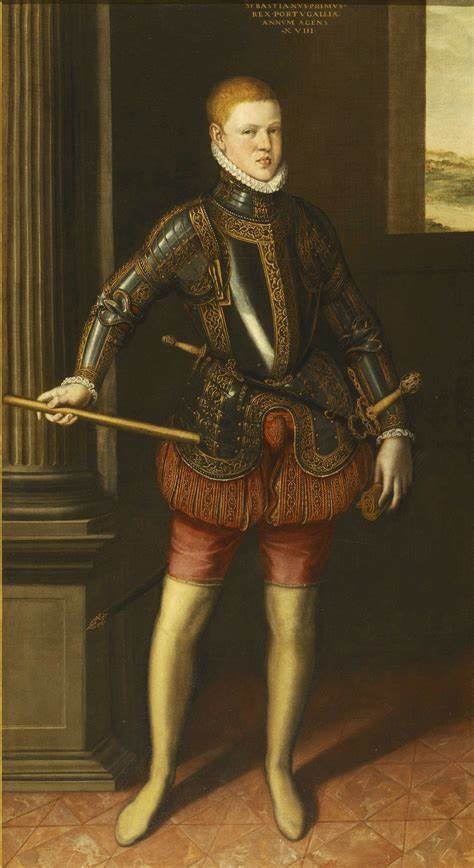
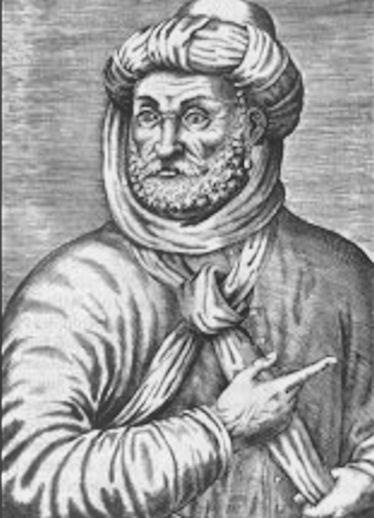
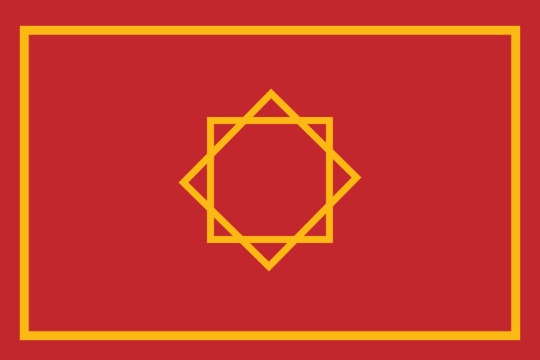
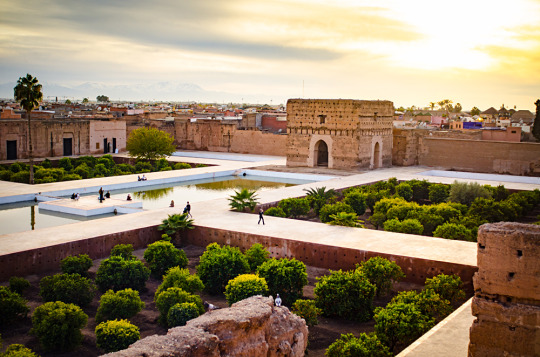
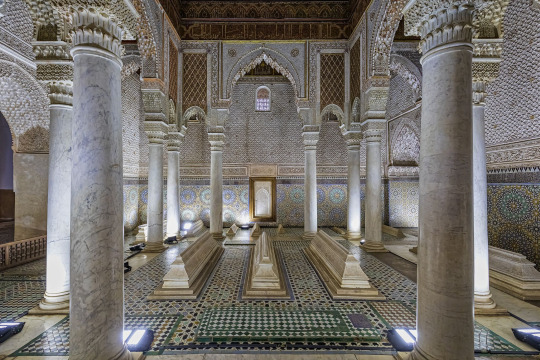
#morocco#moroccan#portugal#saadi#aviz#ottoman empire#saadi dynasty#saadian tombs#marrakesh#fez#battle of Alcacer Quibir#16th century#colonialism#imperialism#crusades#islam#sufism#berber#amazigh#arab#turk#portuguese#spain#hapsburgs#military history#songhai empire#sahara#africa
4 notes
·
View notes
Photo

Flag of Morocco between 1258–1659, used by the Marinid, Wattasid and Saadi dynasties
from /r/vexillology Top comment: Why did they change it?? The green on red is too conflicting and too dark.
32 notes
·
View notes
Text
Separatist and irredentist movements in the world
Rif
Proposed state: Republic of the Rif
Region: Rif, Morocco
Ethnic group: Rifians
Goal: independence
Date: 1921
Political parties: -
Militant organizations: Rif Independence Movement (RIM)
Current status: inactive
History
11th century BCE - Phoenician trading posts
814-146 - Carthaginian Empire
145 - the Rif becomes part of the Roman Empire
5th century CE - Vandal control
6th century - Byzantine Empire
661-750 - Umayyad Caliphate
710-1019 - Emirate of Nekor
1040-1147 - Almoravid Empire
1121-1269 - Almohad Caliphate
1244-1465 - Marinid Sultanate
1472-1554 - Wattasid dynasty
1510-1659 - Saadi Sultanate
1631-present - ‘Alawi dynasty
1912-1956 - French and Spanish protectorates in Morocco
1921-1926 - Rif Republic
1958-1959 - Rif revolt
2013 - reinvigoration of the RIM
The Rif has been inhabited by the Imazighen (Amazigh people) since prehistoric times. It has been a part of the Phoenician, Carthaginian, and Roman empires and was briefly under Vandal control.
The Emirate of Nekor was founded in 710 and Imazighen started converting to Islam. This was followed by a series of Amazigh dynasties between the 11th and 16th centuries and two Arab dynasties from the 16th century until the present day.
In 1912, France and Spain established two protectorates in Morocco. The majority of the Rif region was under Spanish rule until 1956, except between 1921 and 1926, when the Republic of the Rif was established as an independent state from Spanish occupation and the Alawite sultan. It was during this time that the RIM was founded.

After Morocco’s independence in 1956, Rifians rose to protest against the government’s marginalization and neglect of the Rif. After the Arab Spring, the RIM was revitalized, but no further steps have been taken toward independence.
Rifian people
There are around 7.5 million Rifians. They mainly live in Morocco, but can also be found in Belgium, France, Germany, the Netherlands, and Spain.
They speak Tarifit, an Amazigh language of the Afro-Asiatic family, and practice Sunni Islam but retain some pre-Islamic traditions.
The Rifians are divided into several tribal groups and organize themselves patrilineally. They mostly live an agricultural lifestyle and some practice fishing.
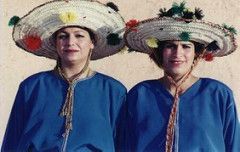
Vocabulary
ⴰⵔⵔⵉⴼ (Arrif) - Rif
Irifiyen - Rifians
Iweṭṭasen - Wattasid dynasty
Izigzawen - Greens (PDA)
Tagduda en Arrif - Republic of the Rif
ⵜⴰⵔⵉⴼⵉⵢⵜ (Tmaziɣt) - Tarifit
13 notes
·
View notes
Text
A Visit to the Saadian Tombs in Marrakech

Tombs from the Saadi Dynasty that ruled Morocco for nearly 100 years beginning in 1549. The Saadian Tombs can be found at the southwestern part of the Old Medina and near Palais El Badii. The Saadian Tombs The enclosure consists of two main mausoleums, with 66 tombs laid out within them and over 100 more outside in the gardens. The first mausoleum, seen on the left as you enter, is the finest of the two. Built to house Mansour's tomb and completed during his lifetime, its vaulted roof, fine carvings and stunning zellij tiles recall the Alhambra in Granada (built 200 years earlier). The first hall is an oratory and probably not originally intended for burial, but nevertheless contains the thin marble stones of several Saadian princes. Here also is the tomb of the mad Moulay Yazid, which ironically conflicts with the black-and-white script in the hall that reads, "And the works of peace they have accomplished will make them enter the holy gardens." In the back of the mausoleum is a very fine mihrab, supported by a delicate group of columns. El Mansour's tomb is in the domed central chamber, flanked by the tombs of his sons and successors. The second mausoleum is older but less impressive. It was built by Ahmed el Mansour in place of an existing pavilion over the tombs of his mother and of the founder of the Saadian dynasty, Mohammed ech Sheikh. Read the full article
1 note
·
View note
Text
16th King of Portugal (7th of the Aviz Dynasty): King Sebastião of Portugal, “The Desired/ The Asleep”

Reign: 11 June 1557 – 4 August 1578 Acclamation: 16 June 1557; Lisbon Predecessor: João III
Sebastian (20 January 1554 in Lisbon – 4 August 1578 in Alcácer-Quibir) was King of Portugal from 11 June 1557 to 4 August 1578 and the penultimate Portuguese monarch of the House of Aviz.
He was the son of João Manuel, Prince of Portugal, and his wife, Joana of Austria. He was the grandson of King João III of Portugal and Holy Roman Emperor Charles V. He disappeared (presumably killed in action) in the battle of Alcácer Quibir. Sebastião I is often referred to as The Desired (o Desejado) or The Asleep (o Adormecido), as the Portuguese people longed for his return to end the decline of Portugal that began after his death. He is considered to be the Portuguese example of the king in the mountain legend as Portuguese tradition states his return, in a foggy dawn, on Portugal's greatest hour of need.

Sebastião was born shortly after eight in the morning of 20 January 1554 (the feast of Saint Sebastian), and he was given the saint's name in commemoration. The name Sebastião was highly unusual for members of any European royal family at the time.
Shortly after his birth, a doctor, Fernando Abarca Maldonado, who had come to Portugal in the entourage of his mother and probably had helped deliver him, cast his horoscope. Among other things, Maldonado predicted that Sebastião would be very attracted to women, marry and have many children. None of these predictions ever came to pass. Actually Sebastião didn’t like women, but he liked men. According to some records he had many encounters with his male servants, and he thought the love between a man and woman was a disgusting thing.

Sebastião was born heir-apparent to the throne of Portugal, since his birth occurred two weeks after the death of his father. He succeeded to the throne at the age of three, on the death of King João III, his paternal grandfather. Soon after his birth, his mother Joana of Spain left her infant son to serve as regent of Spain for her father, Emperor Charles V. After his abdication in 1556, she served in the same capacity for her brother Philip II of Spain. Joana remained in Spain until her death in 1573, never to see her son again.
Since Sebastião was still a child, a regency was necessary. It was handled first by his paternal grandmother, Catarina of Austria, and then by his great-uncle, Cardinal Henrique of Évora. This period saw continued Portuguese colonial expansion in Angola, Mozambique, and Malacca, as well as the annexation of Macau in 1557.
Sebastião was a bright and lively boy. Reports say he was fearless due to his great physical strength. Tall, slim, and blond, he was brought up by his grandmother Catarina, a domineering woman who exercised firm control over her grandson. Obedient as a child, he became obstinate and impulsive in later life.

The young king grew up under the guidance and heavy influence of the Jesuits. Aleixo de Meneses, a military man of solid reputation and former tutor and guardian of Prince João, was appointed tutor to Sebastião by the boy's grandmother. Other teachers included the priest Luís Gonçalves da Câmara and his assistant, the priest Amador Rebelo.
His upbringing made Sebastião extremely devout. He carried a copy of Tomás Aquinas

on a belt at his waist and was constantly accompanied by two monks of the Theatine Order who were intent on preserving the king's innocence. As a child, Sebastião reportedly would react to visitors by running off into hiding with the monks until the visitors had gone.

Sebastião died young and did not marry. However, he was involved in several proposed marriage alliances. In particular, the Queen dowager of France, Catherine de' Medici,

nurtured a plan for a long time to marry her youngest daughter, Margaret of Valois,

to Sebastião, a plan which was supported by Sebastião's maternal uncle, King Philip II of Spain, on occasion. Later, Margaret married Henry Bourbon, King of Navarre.
Sebastião himself, however, put an end to that plan, declaring that he was unimpressed by the mild suppression of the Huguenot Protestants in France, and that he would not bind himself to the House of Valois until he had seen how the situation would develop. Later, he agreed — being persuaded by emissaries of the Pope — to marry Margaret in order to prevent her from marrying the Huguenot Henry of Navarre;

by that time, however, the French king and his mother were already intent on Margaret marrying Henry. Margaret married Henry in 1572. By then, Sebastião's proposal was rejected.
Sebastião was also offered his cousin Elisabeth of Habsburg,

the daughter of Emperor Maximilian II

(Maximilian was Charles V's nephew.). Sebastião himself made a proposal in 1577 to his first cousin Isabel Clara Eugenia,

daughter of Philip II of Spain (Philip was Charles' son.).
During Sebastião's short personal reign, he strengthened ties with the Holy Roman Empire, England and France through diplomatic efforts. He also restructured much of the administrative, judicial and military life in his kingdom. In 1568, Sebastião created scholarships to assist students who wished to study medicine or pharmacy at the University of Coimbra.

That same year he rewarded Indians in Brazil who helped in the fight against the French. The chief of the Temiminós Indians, Araribóia, was given lands near the Bay of Guanabara. In 1569, Sebastião ordered Duarte Nunes de Leão to compile all the laws and legal documents of the kingdom in a collection of Leis Extravagantes known as the Código Sebastiânico (Sebastião's code).
During the great plague of Lisbon in 1569, Sebastião sent for doctors from Seville to help the Portuguese doctors fight the plague. He created two hospitals in Lisbon to take care of those afflicted with the disease.
In his concern for the widows and orphans of those killed by the plague, he created several Recolhimentos (shelters) known as the Recolhimento de Santa Marta (shelter of Santa Marta) and the Recolhimento dos Meninos (shelter of the children) and provided wet nurses to take care of the babies.

Sebastião created laws for the military, the Lei das Armas, that would become a military organization model. In 1570, Goa was attacked by the Indian army, but the Portuguese were successful in repulsing the assault. Also in 1570, Sebastião ordered that the Brazilian Indians should not be used as slaves and ordered the release of those held in captivity.
In 1572, the poet Luís de Camões presented his masterpiece Os Lusíadas and dedicated a poem to Sebastião that won him a royal pension. In 1573, he commissioned the construction of the Royal Basilica in Castro Verde as a tribute to the Battle of Ourique. In 1575 with the Carta de Lei de Almeirim, the king established a system of measures for solid and liquid products and also defined the role of public servants.
The Celeiros Comuns (Communal Granaries) were inaugurated in 1576 on Sebastian's orders. These were lending institutions intended to help to poor farmers when farm production decreased, giving credit, lending seeds and commodities to the needy. They were allowed to pay back their debts with farm products when they recovered from losses.
The mathematician and cosmographer Pedro Nunes was appointed by Sebastião as a cosmography teacher for sea pilots. It was during Sebastian's reign that Nunes wrote his Petri Nonii Salaciensis Opera.
In 1577, Sebastião's ordinance Da nova ordem do juízo, sobre o abreviar das demandas, e execução dellas decreased the time for handling legal actions, regulated the action of lawyers, scribes and other court officials, and created fines for delays.

After attaining his majority in 1568, Sebastião dreamed of a great crusade against the kingdom of Morocco, where over the preceding generation several Portuguese way stations on the route to India had been lost.
A Moroccan succession struggle gave him the opportunity, when Abu Abdallah Mohammed II Saadi lost his throne in 1576 and fled to Portugal. After arriving, he asked for King Sebastião's assistance in defeating his Turkish-backed uncle and rival, Abu Marwan Abd al-Malik I Saadi.
During the Christmastide of 1577, Sebastião met with his uncle King Philip II of Spain at Guadalupe. Philip refused to be party to the crusade as he was negotiating a truce with the Ottoman Empire, though he promised a contingent of Spanish volunteers.
Despite his lack of a son and heir, King Sebastião embarked on his crusade in 1578. The Portuguese army of 17,000 men, including a significant number of foreign mercenaries hired from the Holy Roman Empire, the Netherlands, Spain, and the Italian States, and almost all of the country's nobility, sailed at the beginning of June from Lisbon. They visited Cádiz, where they expected to find Spanish volunteers who failed to appear, then crossed into Morocco.
At Arzila, Sebastião joined his ally Abu Abdullah Mohammed II, who had around 6,000 Moorish soldiers and, against the advice of his commanders, marched into the interior. At the Battle of Alcácer Quibir (Battle of the Three Kings),

the Portuguese army was routed by Abd Al-Malik at the head of more than 60,000 men.
Sebastião was almost certainly killed in battle. He was last seen riding headlong into the enemy lines. Whether his body was ever found is uncertain, but Philip II of Spain claimed to have received his remains from Morocco and buried them in the Jerónimos Monastery in Belém, Lisbon, after he ascended to the Portuguese throne in 1580.


The body could not be identified as Sebastião's, however, which left some people unconvinced of his death. Sebastião was succeeded as king by his great-uncle Henrique, brother of his grandfather, King João III.
After the defeat at Alcácer Quibir, many efforts were made to ransom imprisoned Portuguese soldiers. Several soldiers returned to Portugal, which led many Portuguese to believe Sebastião had survived the battle and would return to claim his throne. This led to Sebastianism, the belief that Sebastião could return at any moment.

Politically, there was a belief that Philip was not the rightful heir to the throne. Subsequently, Imposter pretenders appeared in Portugal who fraudulently claimed to be the king.
During the time of the Iberian Union, between 1580 and 1640, four different pretenders claimed to be the returned King Sebastião. The last of these pretenders, who was in fact an Italian, was hanged in 1619, while another was obtained by the Spanish from Venice, tried, found guilty and hanged in 1603.
In the long term, many myths and legends about Sebastião appeared, the principal one being that he was a great Portuguese patriot, the "sleeping king" who would return to help Portugal in its darkest hour (similar to the British King Arthur, the German Frederick Barbarossa or the Byzantine Constantine XI Palaeologus).
He came to be known by symbolic names: O Encoberto (The Hidden One) who would return on a foggy morning to save Portugal, or as O Desejado (The Desired One).
These legends were vigorously promoted through the massive circulation of popular rhymes (trovas) written by António Gonçalves de Bandarra.
Even as late as the 19th century, "Sebastianist" peasants in the town of Canudos in the Brazilian sertão believed that the king would return to help them in their rebellion against the "godless" Brazilian republic.
Sebastião's life was dramatized in 1843 in the opera Dom Sébastien by the Italian composer Gaetano Donizetti. Belgian playwright Paul Dresse also dramatized his life in the 1975 play Sébastien de Portugal ou le Capitaine de Dieu. The legend of Sebastião's disappearance and alleged return is the basis for the popular song "A Lenda d'El Rei D. Sebastião" ("The Legend of King Sebastian") by the Portuguese band Quarteto 1111 (1968).
4 notes
·
View notes
Text
The Saadi are not Black but still matter very much for Black history:
The Saadi are ultimately one of the most crucial forces in Black history as a whole even when they were not only not Black, but like the late Muammar Gadaffi a good example of how pale-skinned North Africans happily swooped down on Black Sahelian peoples to butcher and burn whenever the opportunity permitted. In turn the Saadi were one of many dynasties to arise from the late 1400s to 1500s shifts in the Muslim world sparked by the fall of Granada and the expansion of the Ottoman Empire and the Habsburg Empire, of which Spain would spend earlier histories as a part of.
The Saadi, like other dynasties, gained and kept power precisely for the ability to keep the European Christians out, and that same power relied on the gunpowder forces seen on much larger scales with Ottomans, Safavids, and Mughals. Their armies did include Sipahi cavalry in turn, but the main forces were cannons and muskets and these were the forces that would turn on the Songhai at Tondibi and finally and brutally shook the Sahel out of its 'guns, meh' complacency.
Because of this when the Portuguese showed up offering the rulers of this part of the world gunpowder in exchange for slaves, this was precisely a bargain they were predisposed to take. In short, the starting gun of things (phrasing chosen with malice aforethought) was not something Europeans did, but an event of which they would have known little and cared less.
#lightdancer comments on history#black history month#against eurocentrism#military history#muslim history#saadi dynasty#atlantic slave trade
0 notes
Text
Events 3.13
624 – The Battle of Badr, the first major battle between the Muslims and Quraysh. 1567 – The Battle of Oosterweel, traditionally regarded as the start of the Eighty Years' War. 1591 – At the Battle of Tondibi in Mali, Moroccan forces of the Saadi dynasty, led by Judar Pasha, defeat the Songhai Empire, despite being outnumbered by at least five to one. 1639 – Harvard College is named after clergyman John Harvard. 1697 – Nojpetén, capital of the last independent Maya kingdom, falls to Spanish conquistadors, the final step in the Spanish conquest of Guatemala. 1741 – The Battle of Cartagena de Indias (part of the War of Jenkins' Ear) begins. 1781 – William Herschel discovers Uranus. 1809 – Gustav IV Adolf of Sweden is deposed in the Coup of 1809. 1811 – A French and Italian fleet is defeated by a British squadron off the island of Vis in the Adriatic during the Napoleonic Wars. 1826 – Pope Leo XII publishes the apostolic constitution Quo Graviora in which he renewed the prohibition on Catholics joining freemasonry. 1845 – Felix Mendelssohn's Violin Concerto receives its première performance in Leipzig with Ferdinand David as soloist. 1848 – The German revolutions of 1848–1849 begin in Vienna. 1862 – The Act Prohibiting the Return of Slaves is passed by the United States Congress, effectively annulling the Fugitive Slave Act of 1850 and setting the stage for the Emancipation Proclamation.[ 1884 – The Siege of Khartoum begins. It lasts until January 26, 1885. 1900 – British forces occupy Bloemfontein, Orange Free State, during the Second Boer War. 1920 – The Kapp Putsch briefly ousts the Weimar Republic government from Berlin. 1930 – The news of the discovery of Pluto is announced by Lowell Observatory. 1940 – The Winter War between Finland and the Soviet Union officially ends after the signing of the Moscow Peace Treaty. 1943 – The Holocaust: German forces liquidate the Jewish ghetto in Kraków. 1954 – The Battle of Điện Biên Phủ begins with an artillery barrage by Viet Minh forces under Võ Nguyên Giáp; Viet Minh victory led to the end of the First Indochina War and French withdrawal from Vietnam. 1957 – Cuban student revolutionaries storm the presidential palace in Havana in a failed attempt on the life of President Fulgencio Batista. 1969 – Apollo 9 returns safely to Earth after testing the Lunar Module. 1979 – The New Jewel Movement, headed by Maurice Bishop, ousts the Prime Minister of Grenada, Eric Gairy, in a coup d'état. 1988 – The Seikan Tunnel, the longest tunnel in the world with an undersea segment, opens between Aomori and Hakodate, Japan. 1992 – The Mw 6.6 Erzincan earthquake strikes eastern Turkey with a maximum Mercalli intensity of VIII (Severe). 1993 – The 1993 Storm of the Century affects the eastern United States, dropping feet of snow in many areas. 1996 – The Dunblane massacre leads to the death of sixteen primary school children and one teacher in Dunblane, Scotland. 1997 – The Missionaries of Charity choose Sister Nirmala to succeed Mother Teresa as their leader. 2003 – An article in Nature identifies the Ciampate del Diavolo as 350,000-year-old hominid footprints. 2012 – The Sierre coach crash kills 28 people, including 22 children. 2013 – The 2013 papal conclave elects Pope Francis as the 266th Pope of the Catholic Church. 2016 – The Ankara bombing kills at least 37 people. 2016 – Three gunmen attack two hotels in the Ivory Coast town of Grand-Bassam, killing at least 19 people. 2020 – President Donald Trump declares the COVID-19 pandemic to be a national emergency in the United States. 2020 – Breonna Taylor is killed by police officers who were forcibly entering her home in Louisville, Kentucky; her death sparked extensive protests against racism and police brutality.
1 note
·
View note
Text
Alp Arslan
Alp Arslan (Persian: آلپ ارسلان; full name: Diya ad-Dunya wa ad-Din Adud ad-Dawlah Abu Shuja Muhammad Alp Arslan ibn Dawud) (20 January 1029 – 15 December 1072) was the second Sultan of the Seljuq Empire and great-grandson of Seljuq, the eponymous founder of the dynasty. His real name was Muhammad bin Dawud Chaghri, and for his military prowess, personal valour, and fighting skills he obtained the name Alp Arslan, which means "Heroic Lion"[2] in Turkish.
Career
Alp Arslan succeeded his father Çağrı Bey as governor of Khorasan in 1059. His uncle Tughril died and was succeeded by Suleiman, Arslan's brother. Arslan and his uncle Kutalmish both contested this succession. Arslan defeated Kutalmish for the throne and succeeded on 27 April 1064 as sultan of Great Seljuq, thus becoming sole monarch of Persia from the river Oxus to the Tigris. In consolidating his empire and subduing contending factions, Arslan was ably assisted by Nizam ul-Mulk, his vizier, and one of the most eminent statesmen in early Muslim history. With peace and security established in his dominions, Arslan convoked an assembly of the states and declared his son Malik Shah I his heir and successor. With the hope of capturing Caesarea Mazaca, the capital of Cappadocia, he placed himself at the head of the Turkish cavalry, crossed the Euphrates, and entered and invaded the city. He then marched into Armenia and Georgia, which he conquered in 1064. Alp Arslan's strength lay in the military realm.
Domestic affairs were handled by his able vizier, Nizam al-Mulk, the founder of the administrative organization that characterized and strengthened the sultanate during the reigns of Alp Arslan and his son, Malik Shah. Military fiefs, governed by Seljuq princes, were established to provide support for the soldiery and to accommodate the nomadic Turks to the established Anatolian agricultural scene. This type of military fiefdom enabled the nomadic Turks to draw on the resources of the sedentary Persians, Turks, and other established cultures within the Seljuq realm, and allowed Alp Arslan to field a huge standing army without depending on tribute from conquest to pay his soldiers. He not only had enough food from his subjects to maintain his military, but the taxes collected from traders and merchants added to his coffers sufficiently to fund his continuous wars.
According to the poet Saadi Shirazi:
Arslan possessed a fort, which raised at the height of Alwand,[disambiguation needed] from all were those within its walls, for its roads were a labyrinth, like the curls of a bride. From a learned traveler Arslan once inquired: "Didst thou ever, in thy wanderings, see a fort as strong as this?" "Splendid it is," was the travelers reply, "but methinks not it confers much strength. Before thee, did not other kings possess it for a while, then pass away? After thee, will not other kings assume control, and eat the fruits of the tree of thy hope?"
In the estimation of the wise, the world is a false gem that passes each moment from one hand to another. (the fort was sacked by the Mongols led by Hulagu).
Suleiman ibn Kutalmish was the son of the contender for Arslan's throne; he was appointed governor of the north-western provinces and assigned to completing the invasion of Anatolia. An explanation for this choice can only be conjectured from Ibn al-Athir’s account of the battle between Alp-Arslan and Kutalmish, in which he writes that Alp-Arslan wept for the latter's death and greatly mourned the loss of his kinsman.
Death
After Manzikert, the dominion of Alp Arslan extended over much of western Asia. He soon prepared to march for the conquest of Turkestan, the original seat of his ancestors. With a powerful army he advanced to the banks of the Oxus. Before he could pass the river with safety, however, it was necessary to subdue certain fortresses, one of which was for several days vigorously defended by the governor, Yussuf el-Harezmi, a Khwarezmian. He was obliged to surrender, however, and was carried as a prisoner before the sultan, who condemned him to death. Yussuf, in desperation, drew his dagger and rushed upon the sultan. Alp Arslan, who took great pride in his reputation as the foremost archer of his time, motioned to his guards not to interfere. He drew his bow, but his foot slipped, the arrow glanced aside, and he received the assassin's dagger in his breast. Alp Arslan died from this wound four days later, on 25 November 1072, in his 42nd year, and he was taken to Merv to be buried next to his father, Chaghri Beg. Upon his tomb lies the following inscription:
“O those who saw the sky-high grandeur of Alp Arslan, behold! He is under the black soil now...”
As he lay dying, Alp Arslan whispered to his son that his vanity had killed him. "Alas," he is recorded to have said, "surrounded by great warriors devoted to my cause, guarded night and day by them, I should have allowed them to do their job. I had been warned against trying to protect myself, and against letting my courage get in the way of my good sense. I forgot those warnings, and here I lie, dying in agony. Remember well the lessons learned, and do not allow your vanity to overreach your good sense..
0 notes
Text
Marrakech Tours
Typically neglected as a vacation spot, the capital of Morocco gives vacationers a refreshing view away from previous European locations. And here are 5 issues about Marrakech that make it so:
1. The luxurious tradition - Established on the foot of the Atlas mountains, Marrakech is an alluring mixture of Spanish, Arabic, and French cultures and all are evident in its historic air. The town is peppered with rust-colored ruins left from historic eras.
2. The souks - These open-air markets are what most individuals go for! Those in Medina are world-famous and shopkeepers typically converse fluent Arabic and French and generally English and Spanish. You could find nearly something on the market right here even wood doorways!
three. The Koutoubia Minaret - The tallest minaret within the metropolis stands 70 meters tall and dates to the 12th century. Solely Muslims can go into the mosque, however, anybody can admire it from outdoors. Hold an ear out for the prayer bells! Read More
four. The Saadian Tombs - Constructed by a sultan within the 16th century, these tombs are a significant vacationer hotspot. The mausoleum itself holds about 60 our bodies of the Saadi Dynasty. Each room is extraordinarily ornamental and breathtakingly beautiful, adorned with cedar wood and stucco.
5. Medina - The previous, walled inside metropolis of Marrakech is usually slender meandering alleyways and ruins, however, it's all the time alive with exercise. Plenty of markets and locations to chill out and other people watch make it a great place for vacationers. The flowery archways are a product of Moorish design and with the mosaics, present a scenic setting.
Related Links:-
https://whereintheworldisnina.com/tours-from-marrakech/ https://www.viator.com/Marrakech/d5408-ttd
1 note
·
View note
Text
Jan Janszoon also known as Murat Reis the Younger (c. 1570-c. 1641) Dutch Barbary Pirate and founder/leader of a pirate republic, Republic of Sale...
Mention pirates and you may well conjure a number of images in the mind. It depends on the context you’re discussing in terms of history and placement in the world. The western world usually has an image of a swashbuckling and misunderstood rogue or misfit outcast who has been rejected from their society or can’t tolerate authority so they take to a life on the high seas in search of freedom, adventure and plunder. Edward Teach (1680-1718) better known as Blackbeard is sometimes cited as the archetypal pirate in many modern works of fiction. Or one might picture the character of Jack Sparrow in the Pirates of the Caribbean film franchise. Images that are based in elements of truth but probably watered down from the reality of the harsh existence pirates found themselves in and the harsh price they exacted from others.
Another type of pirate, widely talked about but not perhaps as well known in some parts of the world is that of the Barbary pirate or Barbary corsair. The Barbary pirate were privateers or pirates from an Islamic background typically and sometimes used a nominally religiously infused perspective to ply their trade. They usually hailed from or were based out of the so called Barbary Coast of North Africa, so named for the native Berber peoples who made up the majority of these lands, Berber being a corruption of the ancient Greek for Barbarian a term applied to all non Greco-Roman peoples in antiquity. These lands were the modern nations of Morocco, Algeria, Tunisia & Libya in particular. These pirates were largely in operation from the 16th-19th centuries with their zenith being in the early to mid 17th century. The modern states of North Africa were not full fledged nation states as they are today, in fact they were instead made up of various city states that with the exception of Morocco were nominal parts of the Turkish Ottoman Empire. These locations while part of the Ottoman sphere of influence had relative degrees of autonomy that fell to their local governors called dey or bey or pasha. All honorific titles taken from Turkish to roughly mean leader or governor. The pirates on behalf of their dey or pasha or sometimes on behalf of themselves had virtual control of over their city-states and the surrounding seas.
The most prominent grounds to find these pirates and their bases was the Western Mediterranean and Atlantic seaboard of Western Europe. Their primary focus was to engage in the plunder of merchant ships and occasionally raid coastal villages and towns. The main target wasn’t so much goods like money or inanimate objects but rather in the capture of people, mostly Europeans and later Americans to become part of the greater Islamic slave trade within the preexisting Ottoman and Arab slave trades which spanned from Asia to Africa and Europe. Now keep in mind slavery was not exclusive to any one society, culture or location, slavery and human trafficking was commonplace on virtually all continents among all peoples during the 16th-19th centuries. However, the focus of this post will be on the Barbary slave trade and to provide a snapshot of the practices within that context.
Not all Barbary pirates were born within the Islamic world, in fact some of the best known were originally Christian or Jewish and later converted to Islam. One of the best known was a Dutchman named Jan Janszoon (Jan Jansen) who took on the later moniker of Murat Reis the Younger...
Early Life...
-Not much of Jan’s early life is documented, other than he was born in the city of Haarlem in the Netherlands in roughly the year 1570. Sources don’t definitively state who his parents were other than we can determine his surname followed the Dutch patronymic naming system of Janszoon or Jansen meaning “son of Jan or son of John” in English.
-At the time of Jan’s birth, the Netherlands was technically part of the Catholic Spanish Empire. However, the ethnic Dutch who were primarily Protestants of the Calvinist Dutch Reformed Church were increasingly at odds with Spanish rule, what resulted was the Eighty Years War or War of Dutch Independence (1568-1648). Seven northern provinces of the Netherlands, one of the most powerful being Holland formed the united nucleus of new country determined to breakaway from Spanish rule. This became the Dutch Republic. What followed was a period of off and on warfare, colonial expansion and a flowering of cultural expression in art, commerce and the establishment of relatively tolerant values based in individualism. This was reflected in the largely Protestant personalized philosophy of their religion. The Dutch Republic became a place of comparative religious freedom within Europe and its government was run more by a legislative body than a monarch, though it had monarch like figures with varying degrees of power, more symbolic than absolute. This contrasted with the absolute monarchy and centralizing of power in most of 17th-18th century Europe.
-Jan’s profession wasn’t known either, other than at some point he took to a life at sea, it is speculated by some sources that he was apprenticed on merchant ships as a teenager which enabled him to learn the skills of sailing and nuances of trade and diplomacy in all dealings that would later serve him in life.
-In 1595, Jan is recorded as marrying a woman, presumably named Soutgen Cave with whom he had at least one daughter and possibly a son, Edward The daughter, Lysbeth, was definitively confirmed by virtually all sources and would play a role in her father’s later life.
-Jan would eventually abandon his family in the Netherlands and would never return to them in a long lasting fashion. Jan appears to have been restless and turned to a life at sea, first as a Dutch privateer on behalf of the Dutch Republic, raiding Spanish merchant ships in an effort to hurt the economy of the nation that nominally ruled over the Dutch Republic.
-However, in the early 17th century a nominal period of peace or truce was established between Spain and the Netherlands, though the war and issue of independence wasn’t officially resolved. Jan during these years appears to have left the official capacity of serving under the Dutch flag and instead made his way to Spain and North Africa and largely went into business for himself.
Algiers and Spain “Turning Turk”...
-The timeline is somewhat confused based on the sources we have but Jan’s adventures appear to have taken him to the Canary Islands off Africa’s coast where he was captured by Barbary pirates, possibly under the Ottoman privateer of Albanian extraction, Murat Reis (The Elder). Jan was conveyed to Algiers (modern capital of Algeria) where he was most likely considered for a life of slavery. However, it appear Jan either made the conversion to Islam outright to officially spare him the pain of slavery, since nominally Islam forbids the enslavement of other Muslims, though this was not always practiced since other Muslims were occasionally enslaved by the Barbary pirates. The other possibility is that Jan convinced his captors of his suitability as a sailor and guide and offered his services if not his faith, though it most likely he converted to Islam at this time, probably as a practical matter. The conversion in European circles was known as “turning Turk” since Turk became a blanket misnomer to all Muslims regardless of ethnicity at this time.
-Jan also made his was to Spain, in particular the port city of Cartagena where in the first decade of the 17th century, some of the last sizable remnants of a Muslim community lived, descended from Muslims that once controlled most of the Iberian Peninsula in the semi-autonomous province of Al-Andalus (Andalusia) from the 8th century to the year 1492.
-Since 1492, the Christian kingdoms of northern Spain and Portugal pushed backed the Muslims and “reconquered” Iberia from Muslim rule. The Spanish monarchy overtime changed from relative tolerance of Muslims and Jews to threats of expulsion, forced conversion or death for non-Christians. In the midst of all this Jan, either not yet a Muslim or a Muslim who as a European could pass for a Christian met a new woman, sources can’t confirm her identity beyond the Spanish name Margarita. Margarita was known to be a Spanish Moor or Muslim of mixed ethnic background, most likely Arab-Berber with roots in Morocco. She was part of a community known as Mujedars or Moriscos, Moors who nominally were converted Christianity but in private secretly maintained their Islamic faith and customs. Sources also vary on whether Margarita was a woman of high birth or nobility or a domestic servant to a Christian family. There is even a source that speculates her genealogy can be traced in part to the then ruling dynasty of Morocco, the Arab Saadi dynasty which claim descent from the Islamic prophet Muhammad through the Prophet’s daughter Fatima.
-What is known is that Margarita would become Jan’s wife, the first of four permissible simultaneous wives under Islamic law. It is not known if Jan ever took another wife. His first Christian marriage in the Netherlands would be viewed as invalid under from the Islamic viewpoint. Jan and Margarita also had four sons whose names are Abraham, Anthony, Philip & Cornelis. All four would have been raised as Muslims by their parents, from this point on this became Jan’s family. His Dutch family is variously reported to have been ignored or still the recipients of child/spousal support from Jan who would send portions of his earnings to them. There is evidently truth to this given that his daughter Lysbeth later visited him late in life, suggesting a good enough relationship if distant.
Sale...
-In roughly the period 1609-1612 the family would have left Spain for Algiers and later Morocco and settled in the city of Sale, today a twin city of the capital of Rabat. Sale had a long history but a number of thousands of expelled Muslims from Spain would come together to form the nucleus of a new period of history in Sale. These Muslims would have differed from the Berbers of Morocco despite their overlapping ethnic similarities, in that they grew up speaking Spanish probably in addition to Arabic and would have had Spanish influenced customs, this put them at odds with their fellow Moroccans.
-Jan in his travels would have been multilingual. In addition to his native Dutch he would have known Spanish and likely Arabic, English and possibly French at the very least.
-1619 saw the city of Sale which had a small Barbary pirate operation already declare itself an independent republic, not subject to the authority of the Sultans of Morocco, then ruled by two brothers of the Saadi dynasty in a virtual state of civil war At the center of this “revolt” was Jan himself, now known as Murat Reis (The Younger), taken after his former captor who had passed away a decade before. Jan was already successful in conducting raids for Algiers on European shipping, mostly of Spanish shipping and other nations. Though he was known to release or ransom his fellow Dutch from captivity in many instances.
-Sale in its newly declared independence was helmed by a ruling council of 14 leading pirates who elected Jan at its Grand Admiral (head of the fleet) and President. The newly minted Republic of Sale, was a functioning de-facto city-state that was run by and for Barbary pirates who enriched themselves off of the slave trade and sale of plunder of other goods taken from European ships.
-Sale’s fleet was small at first, numbering 18 ships, mainly of the “polacca” design, the ships were small, sleek and fast. The harbor at Sale was the mouth of the Bou Regreg river which divided Sale & Rabat on the north and south banks respectively. The harbor was protected by a sandbar and due to the small design of the ships with they had the ability to slide over the sandbar and dock in the shallow harbor, where European ships typically required deep ports for docking due to their deep and large hulls. Sale at the time also benefitted from relative isolation with next to no roads leading to the city from land and it was purely a port city.
-Jan is noted by all sources as an intelligent and brave fighter as well as able administrator, the docking fees, percentages of profits from slave sales and others good sold made Sale blossom financially under Jan’s administration. Nominal fees to the Sultan also helped maintain their semi-autonomy, in recognition of this and due to other deeper difficulties Sultan Zidan Abu Maali of the Saadi dynasty made Jan the ceremonial Governor of Sale.
-Jan and the Sale Rovers as his fleet was called in English sources was known for their guile. Carrying multiple flags on board Jan and fleet were known to approach ships and like a chameleon adapts to their surroundings by changing colors, the pirates would fly friendly flags as they approached their prey. This meant they kept informed on the latest diplomatic changes of the day and using this ruse got close to their quarry and then suddenly would raise their own flag of the two conjoined sabers on a field of green or the crescent moon of Islam and frighten their victims. Barbary pirates in general speaking foreign tongues with a fearsome appearance of swords and pistols in hand and dagger in mouth relied on intimidation and very often tried to capture their victims without an actual fight. Since the goal was enslavement harm or death to their prisoners was not ideal and psychological terror was their foremost weapon hence why they chose merchant and passenger ships and usually fled at the sight of military ships.
-According to the known accounts Jan and his men treated their prisoners relatively humanely given the circumstances as Barbary piracy was well known by this time, most knew their fate would not be good, few slaves ever returned to their homeland or another destination. Typically, women and children would be separated from the men, meaning families were often divided. Once arrived at port, they would be separated according to age and gender since they served different purposes. Men would typically be used for forced manual labor to their Muslim masters or serve as oarsmen or servants on ships, rarely setting foot on land for long periods of time. Children would be taken to serve as domestic servants in Muslim homes and women would typically be sold to become domestic servants as well. Occasionally women were made into sex slaves to their masters, sometimes ending up in the harems of the Sultan or other Muslim rulers. On the auction block as is true of slaves anywhere, one would be publicly displayed sometimes naked or asked to run and jump or to be prodded and inspected by prospective buyers. Those in good health commanded the highest price. Some slaves were also ransomed through funds raised by the family, government or Christian religious orders, though this fueled the Barbary pirates economy and perpetuated the cycle of enslavement. Jan is known to have made large profits to fund his family, fleet and home and is known to have had many servants, most probably being men to perform manual labor in maintaining his fleet for future slave runs.
-Jan also occasionally ventured outside of the Western Mediterranean and Atlantic near the Canary Islands, sight of his own capture years before. He was known to base himself on islands off the coast of England and even return to the Netherlands. Using his Dutch citizenship and his new found role as an Admiral nominally in the Moroccan navy, he had diplomatic immunity and for his service in attacking the hated Spanish, he was viewed with mixed feeling in his homeland as his fame had spread by this time. The authorities banned piracy officially and condemned it and thought him a bad example, even if he exacted a toll on the Spanish economy which rivalled the Dutch and was still at war with them. During one visit back to Amsterdam in 1622, the authorities located his first wife and their children in the hopes the sight of them would spurn him to give up his piracy, it failed. To make matters worse, he had somewhat a folk hero appeal that lead several Dutchmen to actually leave behind their lives in Amsterdam and leave to join his crew for a life of piracy, a testament to the charisma he probably possessed. His crew would have been multiethnic containing other Europeans including Dutch, Spanish, French, English and German crewmen alongside Arabs, Berbers and Turks. Spanish & Arabic would have probably served as lingua francas onboard.
Return to Algiers...
-By 1627, the political situation in Morocco had deteriorated and for safety reasons he took his family to Algiers. His son Anthony had by this time now an adult left Morocco for a life in the Netherlands and would eventually marry a Dutch woman and immigrate under the auspices of the Dutch West India Company to North America, settling in the colony of New Amsterdam, modern day New York City. Anthony was known as Anthony Janszoon Van Salee in Dutch. He was the first Muslim recorded to have been a long term settler in North America and kept the first known copy of a the Qu’ran in America as well, reputed to be a copy of the Moroccan Sultan’s personal Qu’ran which was a gift and a testament to the honorifics bestowed upon the Janszoon family. Anthony became a successful farmer, landowner and merchant in New Amsterdam and helped found settlements that made up modern day Brooklyn, New York. He was known to have an independent streak like his father and little regard for authority, making him a colorful character in colonial America. Through Anthony, Jan has many living descendants in America (see my previous post on Anthony) including the Vanderbilt family which became wealthy in the 19th century.
-Upon his return to Algiers, Jan resumed his piracy this time conducting two of his most famous raids in 1627 and 1631 respectively. First, he had his crew leave from England northward to Iceland of all places, where they captured a couple hundred Icelanders and a few Danes from Denmark, all were sold into slavery in Algiers where Jan continued his large profits. The second took place in Ireland at the village of Baltimore, once more he successfully made off with hundreds of prisoners, only two would ever return to Ireland. This latter raid was lamented in the 19th century Thomas Davis poem The Sack of Baltimore. In both instances, Jan’s crew went ashore and captured villagers from their homes, again using intimidation with probably only enough physical violence so as to intimidate and deter resistance. In the case of the Baltimore raid, Jan’s crew attacked in the middle of the night abducting people from their sleep.
Capture...
-1635 saw Jan captured while at sea in the Eastern Mediterranean, captured by the Christian military order, the Knights of Rhodes or Knights Hospitaller. He was kept on the island of Malta, the details of his confinement are murky, but he was known to have been beaten and subjected to torture though he never renounced Islam and was known to have become quite pious in his faith. He encouraged many European captives to convert and spare themselves slavery as Islam forbids enslavement of other Muslims. In fact, the Muslim view of Jan and his fellow Barbary pirates at the time was widely one of celebration and righteousness. Not only did it provide economic benefit but the enslavement of non-Muslims was viewed as an act of almost holy war waged against infidel peoples and the pirates were warriors of Islam acting in a righteous manner.
-Jan’s imprisonment lasted five years until he was freed by Tunisian Barbary pirates in a raid on Malta. He was heralded with great pomp in 1640 at his release having achieved fame in the Islamic world as well as have been a scourge to Christians in Europe.
Final return to Morocco...
-Jan was essentially in search of work despite his old age and feeble condition from his imprisonment.
-He returned to Morocco but not Sale where he made his name and fortune but instead, the new Sultan made him Governor of Oualidia further south on the Moroccan coast. The modern day seaside resort had a unique lagoon and a new fortress or “Kasbah” was built specifically for Jan. He also maintained a home in nearby Safi, no longer at sea, he retired and merely administered the area but appears to have been restored to his wealth, his wife Margarita is presumed to have predeceased him either in Algiers or Morocco before or during his imprisonment on Malta.
-In 1641 his daughter Lysbeth from his first marriage travelled with a Dutch embassy to Morocco to greet the new Sultan. Lysbeth and her husband met with Jan, supposedly both on their docked ship and and his many homes, he was described as being enfeebled but surrounded by luxury and comfort attended to by servants. Lysbeth stayed with her father for months, the only extended period of time since her childhood, presumably this meant despite his physical distance, their relationship was relatively good.
-No further sources of Jan’s life are known, its presumed he died shortly thereafter of natural causes and was buried in Safi, Morocco in an unmarked grave but no source has yet validated this.


#jan janszoon#barbary pirates#16th century#17th century#pirates#piracy#slave trade#islamic history#military history#morocco#arab world#berbers#moors#dutch republic#spain#al andalus#salee#rabat#algiers#malta#murat reis
22 notes
·
View notes